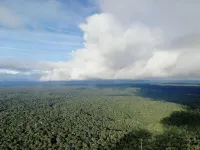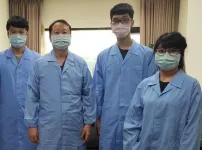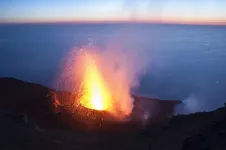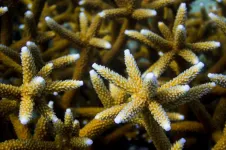(Press-News.org) MISSOULA - The map of Montana Kayla Irish pulls up is peppered with red circles, each cluster providing details behind one of today's timely topics - childhood vaccination.
The project, led by Dr. Sophia Newcomer in the University of Montana's Center for Population Health Research, is the first spatial scan analysis to identify hotspots of undervaccinated children across Montana and evaluate whether they are due to social or geographic barriers.
CPHR is funded through the National Institutes of Health, and the analysis is part of a collaborative study with the Montana Department of Public Health and Human Services to help inform the state's public health measures.
Irish, a history and math major from Lewistown set to graduate from UM this fall, became involved in January after taking a statistics course with UM math Professor Jon Graham, who also is the Data and Modeling Core director of CPHR.
Irish said the project is the first to use data, rather than anecdotes from physicians, on why childhood undervaccination exists in the state.
"Montana is already undervaccinated, and this study overall is trying to find out why and where," Irish said.
The CDC's Advisory Committee on Immunization Practices recommends that by age 2, when they are most vulnerable, children receive the combined 7-vaccine series. These vaccines work against diphtheria, tetanus and pertussis; polio; measles, mumps and rubella; hepatitis B; varicella; Haemophilus influenzae type b; and pneumococcal disease.
According to the CPHR and Montana DPHHS study, published in the American Journal of Preventive Medicine, Montana lags behind the 2019 national childhood combined 7-series vaccination rate of 71%. Just 62% of the children studied completed the vaccine series, and only 38% received them on time - fewer than two in five.
Partnering with DPHHS, the CPHR Data and Modeling Core analyzed immunization data on Montana children born between 2015 and 2017, which includes more than 30,000 kids. Newcomer, an assistant professor in UM's School of Public and Community Health Sciences, led the research effort as one of several projects ongoing in CPHR.
Irish and Graham then used biostatistical modeling and a spatial statistical technique known as spatial scan analysis to identify and create the maps of clusters of undervaccination.
"This technique takes measurements of some variable of interest on a landscape and identifies hotspots of unusual values," Graham said. "Kayla and I read several papers on the spatial scan method, learned how to implement it in the R statistical software package and applied it to the vaccination data."
The research method considers hundreds of thousands of areas throughout the state to identify large and small geographic hotspots with the highest rates of childhood undervaccination of the combined 7-vaccine series. In addition to identifying the clusters, separate analyses identified groups where children may be undervaccinated due to access barriers such as geographic distances and those where parents are hesitant to vaccinate their children.
To identify patterns suggestive of parental hesitancy, the researchers looked for inconsistency in the number of vaccines children received in the series or vaccines spread out over multiple clinic visits.
"Say you have all the different vaccines in the combined 7- vaccine series," Irish said. "If five of them are perfectly on time and two of them aren't happening, that's a pretty clear sign of parents consciously electing not to vaccinate with certain shots."
According to the spatial analysis, parental hesitancy on vaccination is concentrated in the western part of the state.
Structural or access barriers, in contrast, mainly show up on the eastern side. To determine potential structural barriers, the team looked at children missing final vaccine doses or receiving them late.
Irish said looking at the two factors helps researchers understand how to increase vaccination rates in certain areas. Interventions to structural barriers, for example, might include hiring more vaccine program providers or creating programs in nontraditional settings for areas where clinics may be inaccessible, while social media tools and physician-client discussions may aid in addressing parental hesitancy.
"I think it's really cool because the long-term objective of this study is to test and determine ways to intervene," she said. "This is an amazing and great map for that."
Rain Freeman, UM's epidemiology specialist and the project's data manager, analyst and programmer, said national Vaccines for Children Program data showed a substantial dip in routine, pediatric vaccine orders at the beginning of the pandemic. And Montana was not immune to that trend.
Although more recent CDC data shows an uptick in vaccine orders again, it is not enough to catch up on the missed doses. Freeman said making sure children are vaccinated on time is crucial to preventing diseases during COVID-19 like measles, which needs a 95% vaccination rate for herd immunity.
"The problem is if vaccination rates for these preventable diseases dip too far below the estimated thresholds for herd immunity, we're worried that we could have multiple epidemics or outbreaks occurring as social interaction becomes a little more normal," she said.
As a history major, Irish is interested in predicting the next preventable disease outbreak. Promoting community health, helping write a scientific paper, and using and managing data while working on the CPHR project also has prepared her for grad school.
"I'm gaining the skills I'll be needing anyway," she said. "It's unbelievably useful to me. I cannot recommend undergrad research too much."
The CPHR team is currently drafting a paper on these analyses and will submit it for publication in the coming months.
"It's hard not to be excited," Irish said. "I feel so much satisfaction. In computer science, it feels like in everything you do, you write a little bit of code and it always fails, and when you see it actually works, it's so cool. And I have so many of those moments here."
INFORMATION:
By Courtney Brockman, UM News Service
Irvine, Calif., June 21, 2021 -- Cancer immunotherapy involving drugs that inhibit CTLA-4 also activates an unwanted response that may self-limit its efficacy in fighting tumors, according to a new study led by Francesco Marangoni, Ph.D., assistant professor of physiology & biophysics and member of the Institute for Immunology at the University of California, Irvine. Study results are published online in the journal Cell.
Using a person's own immune system - immunotherapy - to treat cancer may also stimulate T regulatory cells, which are essential for preventing autoimmunity, in which the body attacks healthy cells and tissue, but limit tumor control. Some anticancer drugs of the checkpoint inhibitor family block the molecule CTLA-4 and activate ...
Every year in Canada, six trillion litres of municipal wastewater are partially treated and released into the environment, while another 150 billion litres of untreated sewage are discharged straight into pristine surface waters.
Now researchers have found a way to stem that flow: by filtering the waste through the roots of willow trees. Experimenting with a plantation in Quebec, the scientists estimate that over 30 million litres of primary wastewater per hectare can be treated using 'bio-refinery' annually.
Their results were published June 14 in the journal ...
[Brooklyn, New York] - [June 21, 2021] - Applied Biological Laboratories (Applied Bio), a biopharmaceutical company focused on the respiratory disease market, announced that its study published online in Immunology, Inflammation and Disease was able to determine the mechanism behind respiratory inflammation and treat it effectively with Biovanta(TM), a 100% naturally derived, over-the-counter (OTC) drug for cold, cough and sore throat.
The study results also showed that almost all of the leading OTC products on the market can damage the upper respiratory cells and may prolong illness. This research study and its findings represent one of the first major breakthroughs in decades for the cold and flu market.
The study, titled ...
UNIVERSITY PARK, Pa. -- Clickbait headlines might not be as enticing to readers as once thought, according to a team of researchers. They added that artificial intelligence -- AI -- may also come up short when it comes to correctly determining whether a headline is clickbait.
In a series of studies, the researchers found that clickbait -- headlines that often rely on linguistic gimmicks to tempt readers to read further -- often did not perform any better and, in some cases, performed worse than traditional headlines.
Because fake news is a concern on social media, researchers have explored using AI to systematically identify and block clickbait. However, the studies also suggest ...
Amazon rain forests could be at far higher risk of extreme drought than previously thought, according to new research.
An international study, led by the University of Leeds, warns that huge areas in the eastern part of the Amazon face severe drying by the end of the century if action is not taken to curb carbon emissions.
As a result, large amounts of carbon dioxide would be released from the forest into the atmosphere,
adding to the greenhouse gas effect and driving further climate change.
The increased dryness during the Amazon dry season would further threaten the viability of large parts of the rainforest, as trees are already water stressed and there is greater risk of forest fires.
The predicted droughts could also have far-reaching consequences ...
Vanadium oxo (VO) species were often used to oxidise sulfide/amine compounds and alkenes when combined with peroxide oxidants. VO species are well known as important vitamin supplements for potential diabetic prevention. They are highly prevalent as metalloenzyme like haloperoxidase. The current catalyst class comprises VO species, substituted-salicylaldehyde, and alpha-amino acids that are nontoxic and highly enriched in ascidian sea animals and plants. Professor Chien-Tien Chen of NTHU pioneered aerobic asymmetric couplings of 2-naphthol with VO species to form optically active binaphols in 2001 (reported in C&EN News, 79(20), 45-57(2001)), which was believed to proceed in a VO-bound, single/dual-mode activation or free radical-radical/free ...
What causes an eruption? Why do some volcanoes erupt regularly, while others remain dormant for thousands of years? A team of geologists and geophysicists, led by the University of Geneva (UNIGE), Switzerland, has reviewed the literature on the internal and external mechanisms that lead to a volcanic eruption. Analyzing the thermo-mechanics of deep volcanic processes and magma propagation to the surface, together with magma chemistry, the geologists determined that most of the magma rising from depth actually does not cause a volcanic eruption. They also show that older volcanoes tend to produce less frequent, but larger and more dangerous eruptions. Their findings, published in Nature Reviews ...
A new study published in Nature Communications demonstrates the important role that planting new commercial forests could play in the fight against climate change by including new accounting of greenhouse gas (GHG) mitigation achieved from future use of harvested wood.
The study applied a novel, time-dependent assessment to capture the complex dynamics of carbon uptake, storage and partial eventual release back to the atmosphere, alongside product and energy substitution by wood products, over a 100-year timeframe.
Uniquely, the study considered multiple wood uses along multi-decadal cascading value chains (e.g. construction timber to paper to bioenergy), and future projections on wider decarbonisation of substituted ...
Although the emissions targets for aviation are in line with the overall goals of the Paris Agreement, there is a high likelihood that the climate impact of aviation will not meet these goals, according to a new study.
Aviation is an important contributor to the global economy, but contributes to climate change by creating carbon dioxide (CO2) as well as non-CO2 effects such as forming nitrogen oxides, ozone and contrailcirrus clouds, which all contribute to global warming.
Researchers believe that, as long as the industry stages a recovery, the restrictions placed on global air travel in response to COVID-19 lockdown will only have ...
Warming seas are driving many species of marine life to shift their geographic ranges out of the tropics to higher latitudes where the water is cooler. Florida's reefs will not be able to make that northward move, however, as they will be caught between intolerably hot tropical waters and increasingly frequent water-cooling cold snaps, according to new findings from Florida Institute of Technology, the U.S. Geological Survey, and several other institutions to be published June 22 in Nature's Scientific Reports.
Populations of the main species of reef-building corals are ...





